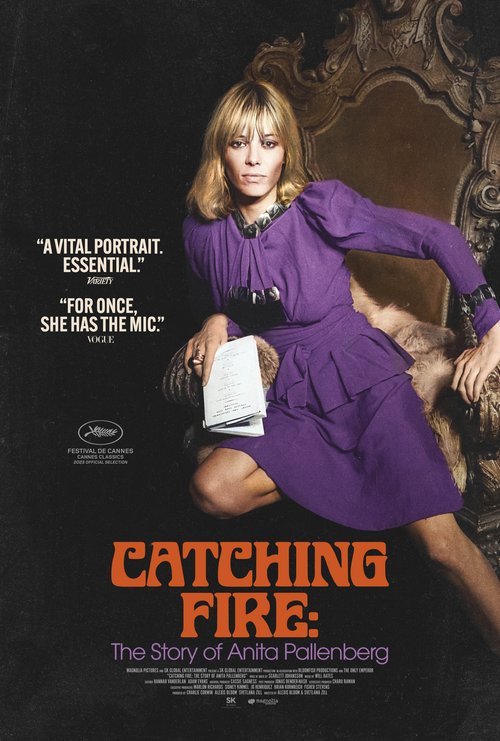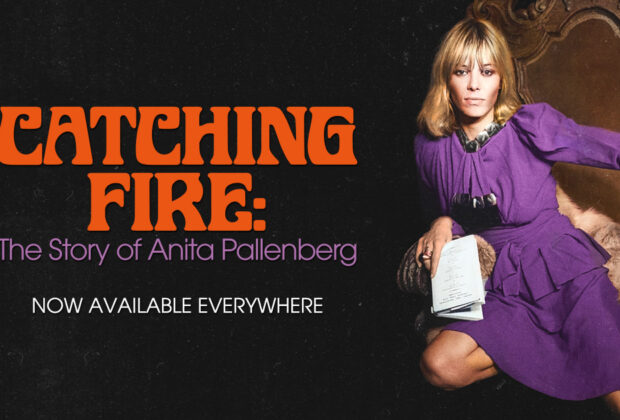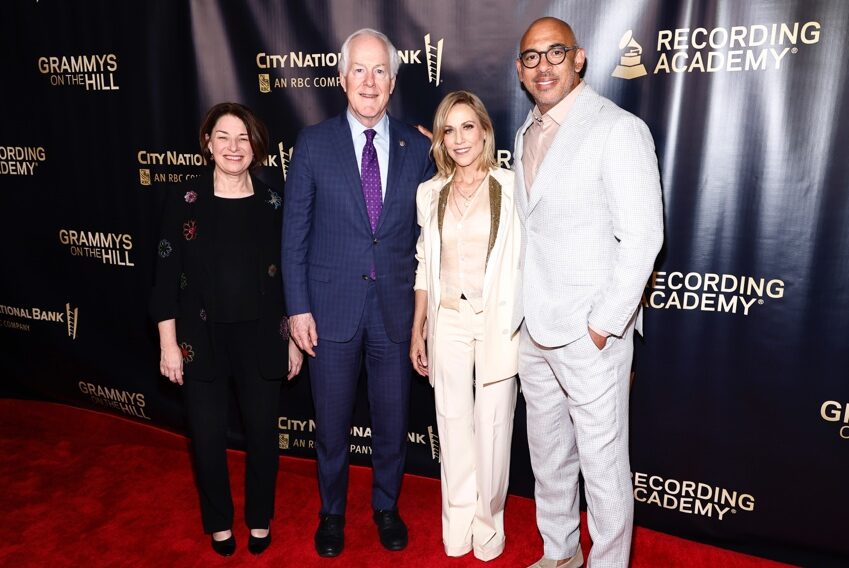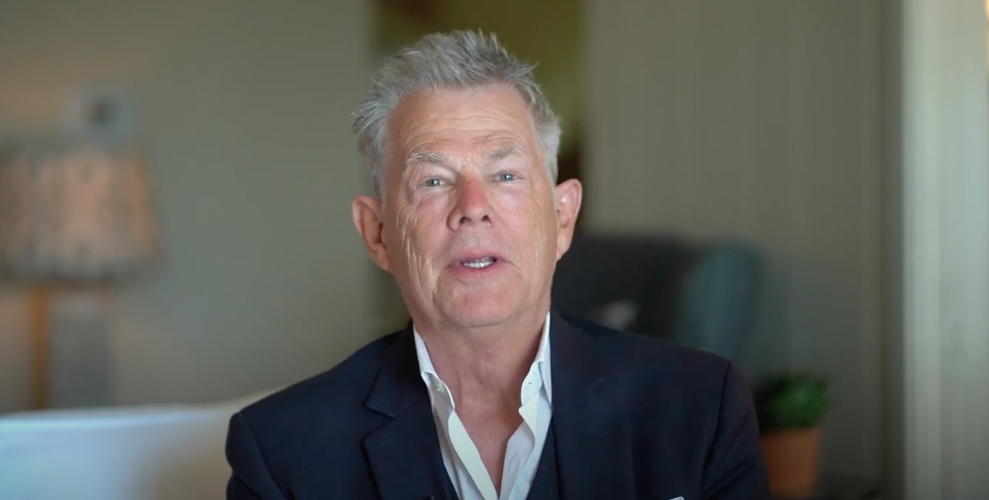Catching Fire – The Story of Anita Pallenberg, debuts in New York as a sneak preview at 7:30 pm at IFC Center on Thursday, May 3, 2024 and may open at more theaters at a later date, and on VOD.
This fascinating documentary comes from Magnolia Pictures.
It’s directed by Alexis Bloom and Svetlana Zill, with the words of Anita Pallenberg read by Scarlett Johansson from Pallenberg’s unpublished memoir. It was an Official Selection 2023 Cannes Film Festival
CATCHING FIRE: THE STORY OF ANITA PALLENBERG is about a woman who was at many points in her life a newspaper headline: Anita Pallenberg was a “rock n’ roll goddess,” a “voodoo priestess,” and an “evil seductress.” She was accused of trying to break up the Rolling Stones, among other things. But those who loved her considered her an exciting cultural force, and a loving mother – and innocent of the accusations. Never-seen-before home movies and family photographs explore life with the Rolling Stones and tell a bittersweet tale of both triumph and heartbreak. From Barbarella to the Swiss Alps, and the Lower East Side to London, Anita Pallenberg was a creative force ahead of her time.
Media materials provided include the Director’s Statement which further describes this captivating movie.
“Catching Fire is a truly hand-made film by two directors motivated by the desire to create something lasting, and personal. It’s a film about family, made by family: Alexis and Svetlana were brought the idea in 2020 by Marlon Richards, the son of Anita Pallenberg and Keith Richards, who wanted his mother’s story to be told in all its complexity. The directors have worked closely with Anita’s inner circle over the course of three years, and the result is a private view of a life that was often lived in public. The Super 8mm home movies woven throughout the documentary are the purest expression of this intimacy.
“Catching Fire is very much an expression of the honesty and love in Anita’s family, but it’s no hagiography. Anita was famous for her biting sense of humor and her contempt of false praise. This film bucks the trend of “branded content” and “celebrity bios” by embracing both the bitter and the sweet, the heartbreak as well as the triumph. Anita Pallenberg is a true anti-hero, an antidote to corporate messaging. The directors approached the film as an act of historical reclamation: putting the female perspective back in the official narrative of rock ‘n’ roll, making Anita visible again.
“For Alexis and Svetlana, Catching Fire was a deliberate recalibrating of history, and a celebration of an unapologetic leader. Anita was doubtless a muse to many, and she continues to be an inspiration to the directors. In the words of one of Anita’s grandchildren: ‘Anita was the original gangster; she was ‘girl power’ to the end.’ Alexis and Svetlana developed the film with the conviction that something this personal can become universal. Anita struggled to balance her own professional life with the needs of her partner, motherhood with a desire for freedom – her themes are absolutely contemporary. The directors hope that Anita’s humor – and theirs - shine through a story that’s unsparing at times. Anita took risks, and so did e directors: this is an immersive documentary with a style and rhythm all of its own.”
Alexis Bloom was born in Johannesburg, South Africa, Alexis now lives in New York. In her early career, she produced widely for the National Geographic Channel, and for BBC World. She also produced extensively for PBS Frontline and NOVA. In 2014, Alexis won the Producers Guild of America Award for We Steal Secrets: The Story of WikiLeaks, a feature documentary for Universal Pictures, also nominated for a BAFTA Award. In 2017, she was nominated for an Emmy for Outstanding Directing for Nonfiction Programming, and an Emmy for Exceptional Merit in Documentary Filmmaking (Bright Lights: Starring Carrie Fisher and Debbie Reynolds, for HBO.) Alexis directed, Divide and Conquer: The Story of Roger Ailes and was nominated for an Emmy Award in 2019. Alexis’ films have shown in film festivals around the world: the Cannes Film Festival, Telluride, Toronto, and the New York Film Festival to name a few.
Director Svetlana Zill is a filmmaker born and raised in New York City. She has worked as a producer for some of the most renowned documentarians of our time including Alex Gibney, Errol Morris, and Morgan Spurlock. She began her career as an archival researcher on Michael Moore’s Capitalism: A Love Story and Mike Mills’ Beginners and worked as a consulting producer for the Academy Award nominated Cutie and the Boxer, which also won an Emmy. Her work explores an impressive range of subjects that include vast CIA conspiracies, eccentric sports fans, pop culture icons and fine artists, and has been presented by HBO, Showtime, Netflix, PBS and The New York Times. Catching Fire is Svetlana’s directorial debut.
Catching Fire is enhanced by an deep archive of rare, unseen photos and home videos. This film truly reveals Pallenberg’s many facets and assets.

It’s very obvious Keith Richards still harbors tender feelings for Pallenberg, and in one reflection summarizes her, “She was a unique piece of work.”
In Catching Fire, Anita finally has a forum to define herself. As she says in her memoir, “Writing this has helped me emerge in my own eyes.”
The cast includes Prince Stanislas Klossowski de Rola, Kate Moss, Angela Richards, Keith Richards, Marianne Faithfull, and Marlon Richards.
I enjoyed the pundits on screen, but surprised that Andrew Loog Oldham, the manager/record producer of the Rolling Stones 1963-1967 is not in Catching Fire as an interview subject.
"Anita joined the group in late '66," Andrew Loog Oldham wrote in an email to me.
"We had come back to the UK, sorta burnt out from 4 years on a rock 'n' pop world tour, and all the recordings. We did one last UK tour with the Ike & Tina Turner Revue. Then the psychedelic period kicked in, the result was Satanic Majesties Request.
"I left three weeks into that, probably 24 hours before I would have been asked to leave. Allen Klein may have taken over the money, but Anita, and Marianne to a lesser extent, took over the game. And the game was strong and the band moved successfully to where they stay today."
Marianne and Anita are heard as background vocals on “Sympathy for the Devil.”
I interviewed Marianne Faithfull in 1995.
She praised Anita and mentioned Pallenberg was working on an autobiography. Some excerpts are heard during Catching Fire.
"Like most of the time I don’t remember what people were wearing.
“I remember what Allen [Ginsberg] was wearing, because often, Allen would take his clothes off. So, I would know that and understand that. And that’s a very simple situation.
"Now Anita actually remembers things only through what we were wearing, ‘cause that’s what she’s interested in. I don’t mean that as a put down,” she smiled.
“But that’s how she remembers things. When I say, 'Do you remember such and such a day…?' The way back for Anita is ‘Oh yeah... You were wearing a red velvet …and I was wearing…’ You’d dig her, man.”
In 1994, Anita Pallenberg graduated from Central Saint Martins in London with a fashion and textile degree.
In April, I saw an advance screening of Catching Fire with photographer and music journalist Heather Harris. She reinforced to me that Pallenberg surpassed her gorgeous European fashion model classification “by seeming to be, to all who encountered her, one of the most reckless extroverts to ever stride the planet.”
Heather emailed me about Catching Fire.
“Her great-grandfather painted one of the most famous, genuine Goth paintings of all time, ‘Isle of the Dead,’ 1880, oil on canvas by Arnold Bocklin, a work of immeasurable dread as a coffin-laden hearse-barge is rowed, lapping on a lake in the dark of night, towards its ominous namesake.
“But Anita Pallenberg attained notoriety for a far different fate, first as the major non-audio influencer of the nascent Rolling Stones, then as an almost worst-case scenario victim of, then survivor of that band's most notorious excesses. Younger music fans of Classic Rock are said to lack context in which to fathom the import of what they're hearing. Catching Fire: The Story of Anita Pallenberg is a newly released documentary that treads a long ways to rectify that.
“Make no mistake, Pallenberg's absence in the band history would have begat a far different Rolling Stones. No matter how superior the music is in and of itself, do not underestimate the importance of strong visuals in modern popular music. We have five senses, and they all work together. And she plugged her own volcanic life force directly into the Stones at just the right minute of the 1960s, which indeed helped codify The World's Greatest Rock and Roll Band.
“She insured they looked different from their frenemies and fellow tastemakers/leaders of all pop culture the Beatles during the style turbulence of the '60s.
“As rock and roll couturier Evita Corby noted (not in the film) ‘Brian Jones, Keith Richards and Anita Pallenberg constantly looked like they all wore one another's clothes,’ which indeed they did, ‘And that they just threw their favorite garments together daily, with zero regard to a matched, put together look’ unlike everyone else in the music biz, fashion biz or even the avant-garde. The resultant mode was Unisex in exotic textiles reflecting worldwide travels alongside cherry-picked exemplars from Granny Takes A Trip appropriated idiosyncratically to their own custom tailors via Pallenberg's personal, outsider taste.
“The doc traces her complexity far beyond her libertine persona familiar to music fans from her years with Keith Richards (and Brian Jones.) Her maternal side is well presented by the movie's producer, her erudite son Marlon Richards, and one of the two Weber brothers who lived when youngsters with Keith and Anita in their Nellcote villa in the south of France, invited to do so when their mother committed suicide and their father had understandable trouble coping.
“Directors Alexis Bloom and Svetlana Zill chose the classical music also used in the film Barry Lyndon to subtly underscore the tragedies in her later life, some of, some not of her own decision-making, often clouded by the extreme distraction of taking narcotics. The fabled sexiness speaks for itself in clips of her leading roles in the films Performance, Barbarella and A Degree of Murder.
“People who encountered her briefly invariably called this beautiful woman ‘scary.’ Folks who knew her better called her ‘intelligent, and a tough cookie.’ The slow, deliberate narration by her friends avoids any tempting cliche of having jumpy-cut style or cinematography to match the ‘wildness’ of the '60s, thankfully. But there is the puzzling choice of having my fellow American Scarlett Johansson voicing Pallenberg's own written words. Pallenberg's own vocals were a mashup of Marlene Dietrich's smoky sophistication and Joan Greenwood's seductive purr (Greenwood in fact was her dubbed voice as the Great Tyrant in Barbarella. Same tone and timbre, but just by the then entertainment world's sexiest plummy voice.) It is jarring, but doesn't inhibit enjoyment of the film. And the home movies footage throughout the documentary is nothing short of incredible.”

In 1965 it was my brother, Kenneth Kubernik, an author and musician, who showed me a photo of Anita in a magazine.
During 2024 he viewed a screener of Catching Fire and emailed me his response to this stunning cinematic portrait of Anita.
“Those twilight feline eyes; a mouth set to snarl, not purr; legs built to stalk, ever conscious of a prey drive that bordered on ravenous. Anita Pallenberg was built from exotic animal parts, as rarefied as a snow leopard and just as agile, just as willful. She didn't arrive on the scene so much as blow up the entire toxic patriarchy that defined the British rock aristocracy of the deathless '60s. Brian, Keith, Mick and all of their pimply devotees became bewitched by her palpable allure. At that time London was choc-a-bloc with Dolly birds sashaying along Kings Road in their Mary Quant minis and their white Courreges boots. Along comes Anita, resplendent in Berber batik, a splash of Bosch and the hauteur of a Barbary coast buccaneer. It wasn't Keith who Depp was copping in those silly films; it was Anita who cast that piratical spell. Her life was a series of escapades and escapes, a survivor of the vicious misogyny that drove the music culture of her time like a runaway train. Wild horses couldn't drag her away.
“The hotly-anticipated documentary of her tempestuous life - Catching Fire; The Story of Anita Pallenberg - exceeds all expectations. The discovery of an unpublished memoir provides a vital narrative backbone (her words read by Scarlett Johansson in her distinctive single malt voice) that delivers just enough self-reflection to suggest we're finally getting close to this mythic creature who never stopped tantalizing both men and women with her singular style. The footage is gob-smacking; Stones fans will lap up every bit of heretofore unseen Super 8 footage that only confirms what our febrile imaginations have been concocting all these years. All the touchstones are checked: Anita's youthful caprice in NYC, meeting Brian in Munich, Courtfield Road, red carpet at Cannes, the madness in Morocco, VilleFranche, the Swiss Alps and on and on. How she persevered through the insanity of those times reminds all of us that even our most fervid projections on our heroes and heroines come at an often ruinous cost to them. Three ABKCO era Stones tracks were licensed for the soundtrack, the rest a pastiche of bluesy British punchins. That's enough - we're all better off with just a taste.
“Marianne Faithfull, a unicorn in her own right, said tellingly about her: "I often used to think that if one spent the evening with Anita, one could very easily get killed." There are worse ways to exit this mortal coil."
During a 2013 interview with record producer and artist manager Denny Bruce, who represented arranger/composer/songwriter and record producer, Jack Nitzsche, Bruce discussed 1966-1969 encounters with Marianne Faithfull, Anita Pallenberg, Brian Jones and Keith Richards.
“Being in Los Angeles in 1966, Keith and Brian wanted to know if anybody, like Lowell Fulson, was playing at any blues club in town? ‘Tramp’ by Lowell was number one this week on their turntables. Jack took the whole band to Watts to see Etta James at the California Club. I went to one of the Aftermath sessions at RCA.
"In fall of 1967 I heard the final mix of Neil Young's ‘Expecting to Fly’ recording on Buffalo Springfield Again one night at Jack’s house. Keith Richards and Anita Pallenberg were there. Jack said it was 'the perfect recording to smoke pot with.'
"Earlier that afternoon I drove Keith and Anita in my Volkswagen to Disneyland. My first Cali car. I clearly remember driving my VW bug with Keith and Anita. That was it - just the three of us. Anita got in and then Keith got in, but didn't move the seat to get in the back. So, it was hard to drive and shift gears with Anita's crotch on the floor mounted gear shift.
"She beamed and said, ‘This is fabulous being in a Volkswagen in Los Angeles!’
"Somewhere in the 1967 or ’68 time period Mick, Keith and Jack worked with Marianne Faithfull on 'Sister Morphine.'
“Keith and Anita liked getting out of the hotels. Marianne and Anita liked to swim in Jack's pool. During their visit we went out to eat several times. A little French place in West Hollywood near Fairfax High School comes into mind.
"'Sister Morphine' was written at Jack's house, during the days of hanging by the swimming pool.
"What people forget was it was hard just to get into Disneyland in those days if you had long hair. I was lucky with Keith and Anita as it was a slow day there, and he was not wearing anything unusual. But showing up as 5 people, looking like a band, would have caused trouble with security.
“Jack and I were hassled when we went there with Buffy St, Marie, who was performing an afternoon show."
In October of 1969, Bruce and Richards went shopping for clothes and rare record albums. Denny schlepped Keith over to Ed Pearl’s Ash Grove music club on Melrose Avenue which housed a record section run by collector Chris Peake. Keith forked out some big bucks for a rare 1965 copy of The Cool Sounds of Albert Collins. Denny at the time managed Collins.
Nitzsche did the choral arrangement for the choir on “You Can’t Always Get What You Want” from the Let It Bleed album. He phoned Merry Clayton to sing on “Gimme Shelter.” Nitzsche was a major contributor to both the Aftermath and Between The Buttons albums.
Nitzsche’s keyboard, harpsichord and percussion work can be heard on such Stones catalog gems as “Play With Fire,” “Yesterday’s Papers,” and “Sister Morphine” on Sticky Fingers. He played tambourine and piano on “Satisfaction,” and was the pianist on “Let’s Spend The Night Together.”
During 2000, I conducted an interview with Jack Nitzsche at his Beachwood Canyon home.
Jack and I talked about the film Performance. His epic soundtrack is still popular and was ground breaking in terms of music merger. Blues, spoken word, and electronic score all in one package. With Mick Jagger co-starring in a movie role.
“The Rolling Stones had nothing to do with it. It was Mick who came to me about doing the soundtrack.
“In fact, Keith and Mick wouldn’t even talking to each other during those days. Somebody came to them to do a movie, which was Christian Marquand, who directed the film, Candy. (Director) Donald Cammell was close to The Stones. He knew who I was from the beginning, and they didn’t have time to score the film. Nor did they want to.
“So, I went to London for some reason, and saw the film during that time. They were doing Let It Bleed. The movie blew my mind the first time I saw it. Jesus Christ. . . I saw it without music. It’s very tame without music. It doesn’t take you to that crazy place. This is the only movie I have ever done where nobody interfered. Nobody.
“When I was in London, the apartment they got me was right around the corner where Keith was living with Anita. There are some pleasant moments but not many because of what they were doing to Brian…
“I thought ‘Memo From Turner’ had a clever lyric. I felt Mick was going in another direction from the band.
“With the film music I was allowed to do musically whatever I wanted to do. No instructions from the director. Nobody telling me yes or no. I did anything I wanted to do I could do. And I made up things in the studio. It was amazing.
“Anita on the screen. God damn! You saw the film. I would want to see the film again. I want to see what’s holding that film up.
“To this day, I’ll be in a restaurant, or walking down a street, or leaving a screening on a lot, like at Paramount, and someone will mention Performance.
“(Director) Billy Friedkin saw me walking across the street and yelled ‘Performance! The greatest use of music in a motion picture ever!’ That was nice.”
Harvey Kubernik in 1969 witnessed his first two concerts by the Rolling Stones in Southern California at the Inglewood Forum.
Kubernik is the author of 20 books, including 2009’s Canyon Of Dreams: The Magic And The Music Of Laurel Canyon, 2014’s Turn Up The Radio! Rock, Pop and Roll In Los Angeles 1956-1972, 2015's Every Body Knows: Leonard Cohen, 2016's Heart of Gold Neil Young and 2017's 1967: A Complete Rock Music History of the Summer of Love.
Sterling/Barnes and Noble in 2018 published Harvey and Kenneth Kubernik’s The Story Of The Band: From Big Pink To The Last Waltz. In2021 they wrote Jimi Hendrix: Voodoo Child for Sterling/Barnes and Noble.
Otherworld Cottage Industries in 2020 published Harvey’s Docs That Rock, Music That Matters. His writings are in several book anthologies, including The Rolling Stone Book Of The Beats and Drinking With Bukowski.
Harvey wrote the liner notes to the CD re-releases of Carole King’s Tapestry, The Essential Carole King, Allen Ginsberg’s Kaddish, Elvis Presley The ’68 Comeback Special, The Ramones’ End of the Century and Big Brother & the Holding Company Captured Live at The Monterey International Pop Festival.
During 2006 he spoke at the special hearings initiated by The Library of Congress held in Hollywood, California, discussing archiving practices and audiotape preservation. In 2017 Kubernik appeared at the Rock and Roll Hall of Fame in Cleveland, Ohio, as part of their Distinguished Speakers Series. For a decade, Harvey has been the Editorial Director of Record Collector News magazine.














